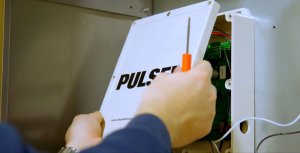Predictive Maintenance Streamlines Operations
With the nClarity predictive maintenance (PdM) platform, Mazza Mechanical transitioned from the traditional preventive maintenance model to a digital-based service, streamlining business operations considerably. Mazza Vice President Ledgie DeRose explained, “We are now able to get early warnings when issues emerge without having to go onsite. This is far more productive than our old approach of dispatching techs 12 times per year.”
Ledgie DeRose continued, “In the event we feel the need to dispatch techs, they are far better prepared with a precise diagnosis, optimizing our time onsite and reducing callbacks. It’s always great when a tech gets onsite before the customer even knows there is an issue.”
Meeting Customer Demands
Brothers Dan and Ledgie DeRose, president and vice president of Mazza, respectively, and their team service some large, innovative manufacturing clients who expect continuous innovation from their partners. Manufacturers are seeing the industrial sector’s evolution to a digitized PdM model, so it was inevitable that Mazza would feel some pressure to migrate to a PdM service model.

The DeRoses began engaging clients in discussions regarding the impact the nClarity technology could have on their operations. The real motivator for most clients was the emphasis on system monitoring integrated into their service operations that drives measurable uptime.
“Our clients are sophisticated operators that understand the value of data in their businesses. Approaching them with a platform that collects machine-level, real-time data that is processed through purpose-built analytics that detect sources of machine degradation and potential failure really addressed a need,” said Dan DeRose.
Package units that service critical areas were targeted in several facilities. Mazza techs installed Pulse circuit boards at each HVAC unit and connected sensors from the Pulse to key components inside each unit (capturing information on supply and return air, high and low side pressure, and temperatures). An onboard, utility-grade meter was connected via a current transformer to unit power. Ledgie DeRose estimated installation took about two hours per unit.
One-minute interval data are routed from each Pulse to a private cellular network (no IT needed), which is then forwarded to nClarity’s service operations analytics engine in the cloud. Ultimately, building insights (i.e., robust alerts) are pushed to service operations dashboards and mobile applications that act as a digital gauge. Service operations personnel are all able to remotely access machine data.
“While a lot of our customers have invested in sophisticated controls, we are convinced implementing a monitoring solution is really what our customers are looking for to meet this need.”
—Ledgie DeRose, Vice President, Mazza Mechanical
“While a lot of our customers have invested in sophisticated controls, we are convinced implementing a monitoring solution is really what our customers are looking for to meet this need,” said Ledgie DeRose. “If we tried to do this with controls, it would be way too complicated, expensive, and not as usable by my service ops team.”
This nClarity article highlights the sales advantages of real-time HVAC monitoring devices: https://www.nclarity.com/blog/the-unfair-sales-advantage-of-iot-based-real-time-hvac-monitoring
A Win-Win Situation
Dan DeRose said, “We are really encouraged by the impact this data is having on our teams and our clients. Even in its early stage, it’s easy to see the value of a predictive service model.”
Mazza is now exploring additional benefits for clients and looking for areas that can drive further productivity gains. “From conducting ‘pre-PMs’ (prioritizing units based on performance before doing onsite preventive maintenance), to engaging in performance data-centric asset planning, to measuring energy consumption with the Pulse’s onboard power meter, we are excited to enter into the next phase of this transition,” said Dan DeRose.
For more information, visit www.nclarity.com/contractor.


